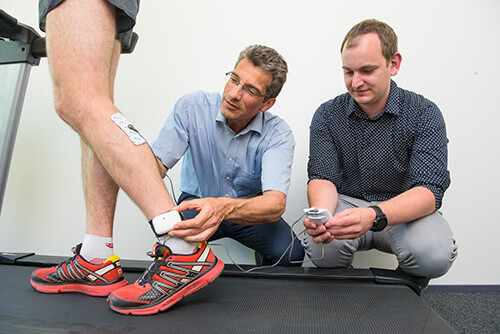Cebit 2018: Digital assistant teaches runners healthier running style

Professor Antonio Krüger and Felix Kosmalla developed a wearable assistant that trains the runner to move properly. Credits: Oliver Dietze / Saarland Informatics Campus
Running over long distances often causes knee injuries. Reasons include the powerful forces that act on the knee when the runner strikes the ground with the heel first. Using the middle or forefoot instead is not only healthier, but also ensures a more efficient running style. Scientists at the German Research Center for Artificial Intelligence (DFKI) and the Research Center for Digital Education (FoBiD) have therefore developed a wearable assistant that trains the runner to move properly. Visitors to the computer fair Cebit will be able to try it out on June 11 at booth G75 in hall 27.
“Studies show that heel runners have an overall injury rate that is approximately twice as high compared to forefoot runners,” explains Antonio Krüger, professor of computer science at Saarland University in Saarbrücken. There Krüger is not only the leader of the Innovative Retail Laboratory, but also manages, together with Professor Julia Knopf, the newly founded Research Center for Digital Education. Hence, he was also interested in the question of whether runners could learn a new movement through information technology alone. “An effective analysis of running technique can only be provided by professionals or expert coaches using slow-motion videos. Amateur athletes have no access to this. However, as more and more people run long distances, exposing themselves to the risk of knee injuries and stress fractures, answering this question is more necessary than ever before,” says Krüger.
Together with Mahmoud Hassan, Florian Daiber, Frederik Wiehr and Felix Kosmalla, he developed the running assistant “Footstriker”. The prototype is worn by the runner on the body and ensures the correct movement with the help of electro-stimulation (EMS).
The painless surges come from electrodes that the runner sticks to the calf. The runner also carries the necessary EMS generator and the control unit, an Arduino microcontroller, on the body. In the shoes are insoles that are equipped with pressure sensors. The sensors allow researchers to see not only whether the runner is striking with the heel, middle or forefoot, but also whether the foot is straight on the ground or in the air. If the foot is in the air and the heel has previously been recognized, the control unit triggers a faint, painless current impulse and the calf muscle folds the foot forward. The runner now strikes with the middle or forefoot, protecting his health and running more efficiently.
The computer scientists have tested their running assistant on 18 people between the ages of 24 and 36 years. They were able to prove that using Footstriker during a run over three kilometers leads to significantly fewer heel-first strikes compared to the classic voice commands of a personal trainer. “After the run with Footstriker we interviewed the runners. The result: They could describe the new, correct movement in their own words, although we had not provided any information about it. Obviously, they had learned it only with the help of the running assistant,” reports Krüger.
At the computer fair Cebit, the researchers invite every visitor to try out the Footstriker on the treadmill (Stand G75, Hall 27).
Further information:
http://umtl.cs.uni-saarland.de/research/projects/footstriker.html
Press photos:
www.uni-saarland.de/pressefotos
Questions can be directed to:
Professor Antonio Krüger
Scientific Director DFKI, FoBiD
Saarland Informatics Campus D3.2
E-mail: Antonio.Krueger@dfki.de
Phone: +49 681 / 85775-5075
Editor:
Gordon Bolduan
Science Communication
Competence Center Computer Science Saarland
Saarland Informatics Campus E1.7
E-mail: bolduan@mmci.uni-saarland.de
Phone: +49 681 302 70741
Die Öffentlichkeitsarbeit am Saarland Informatics Campus wird unterstützt durch das Kompetenzzentrum Informatik Saarland, gefördert aus Mitteln des Europäischen Fonds für regionale Entwicklung (EFRE) und Mitteln der Staatskanzlei Saarland.


